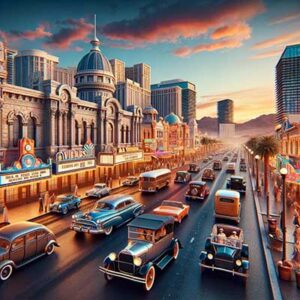Henderson 1900-1949 Did You Know
Henderson's Transformation: The Early 20th Century
The dawn of the 20th century marked a period of significant transformation for Henderson, Nevada. This era was characterized by rapid development and a shift in the city’s identity. From a small, agricultural community, Henderson began its journey towards becoming a modern city.
Henderson’s Journey Through Early 1900's
Reflecting on Henderson’s history from 1900 to 1949 reveals a story of resilience, growth, and transformation. This era was pivotal in shaping Henderson into the city it is today. From industrial expansion to playing a crucial role in the war effort, Henderson’s early modern history is rich and diverse.
This period laid the foundations for the city’s future development. It is a testament to the strength and adaptability of the Henderson community. As we explore Henderson today, we walk through a city shaped by its remarkable history.

1900-1949 Did You Know...
Formation of Basic Magnesium, Inc. (1942): In 1942, Henderson was put on the map with the formation of Basic Magnesium, Inc., which produced magnesium for munitions and airplane parts during World War II.
Construction of the Hoover Dam (1931-1936): The construction of the Hoover Dam, beginning in 1931, brought thousands of workers to the region, significantly impacting the development and economy of the areas surrounding Henderson.
Henderson’s Birth from War Effort (1940s): Henderson officially came into existence during the early 1940s as a result of America’s involvement in World War II, primarily to supply magnesium.
Las Vegas Land Auction (1905): In 1905, a significant land auction occurred in Las Vegas, marking the beginning of formal development in the region and influencing future growth near Henderson.
Establishment of Las Vegas as a Railroad Town (1905): In 1905, Las Vegas was officially established as a railroad town, which significantly contributed to the growth and development of nearby areas, including Henderson.
Boomtown Era (1940s): The 1940s saw Henderson transform into a boomtown, with a rapidly growing population due to its magnesium production, playing a crucial role in the war effort.
Post-War Transition (Post-1945): After World War II, Henderson faced uncertainty as war contracts ceased, but transitioned into an industrial base helping maintain its economy.
Auction of War Surplus Homes (Late 1940s): In the late 1940s, Henderson sold war surplus homes in a unique auction, contributing to the city’s growth and providing housing for a burgeoning population.
First Schools in Modern Henderson (1940s): The first schools in modern Henderson were established in the 1940s, marking the beginning of the city’s educational infrastructure.
Impact of the Hoover Dam (1930s): Te construction of the Hoover Dam in the 1930s had a significant impact on Henderson and the surrounding areas, bringing in workers and boosting the local economy.
Early Agricultural Shifts (Early 1900s): In the early 1900s, the areas around Henderson began shifting from traditional agriculture to more industrial pursuits, setting the stage for the city’s later industrial boom.
City of Henderson Establishment (1943): Henderson was officially established as a city in 1943.
Population Surge (1940s): During the 1940s, Henderson experienced a population surge, growing from a small settlement to a thriving industrial city almost overnight due to the war.
Post-War Magnesium Demand (Post-1945): After World War II, the demand for magnesium decreased, leading to a significant economic and social transition in Henderson as it sought new industries and purposes.
School for War Workers’ Children (1942): In 1942, a school was established in Henderson to educate the children of war workers, marking the beginning of the city’s public education system.
Henderson’s First Airport (1940s): Henderson had its first airport established in the 1940s.
Victory Village Establishment (1940s): A temporary housing area named Victory Village was established in Henderson in the 1940s to accommodate the influx of workers and their families for the magnesium plant.
Henderson’s First Library (Late 1940s): Henderson opened its first library in the late 1940s, indicating the city’s growth in cultural and educational infrastructure.
Black Mountain Golf and Country Club (1940s): The Black Mountain Golf and Country Club, one of Henderson’s oldest recreational spots, was established in the 1940s.
Ethel M Chocolates Origin (1931): Ethel M Chocolates, a renowned Henderson-based chocolatier, traces its roots back to 1931 when Forrest Mars Sr. started making chocolates in his kitchen.
First Mayor of Henderson (1944): In 1944, Henderson elected its first mayor, Dr. Jim French, marking the beginning of its own local government.
Henderson’s First Post Office (1942): Henderson’s first post office was established in 1942.
Henderson Community Church Establishment (1943): The first community church in Henderson was established in 1943, providing spiritual services to the rapidly growing population.
Initial City Planning (1941): In 1941, city planning for Henderson began, focusing on creating a functional city.
Henderson During Prohibition (1920-1933): During Prohibition (1920-1933), Henderson, like much of Nevada, experienced a surge in illegal alcohol trade and speakeasies.
First Fire Department (1942): Henderson’s first fire department was formed in 1942, staffed initially by volunteer firefighters from the plant workers?
Henderson’s First Newspaper (1942): Henderson’s first newspaper, “The Henderson Home News,” was published in 1942, providing the community with local and national news.
Impact of the New Deal (1933-1939): The New Deal programs in the 1930s brought infrastructure improvements and employment opportunities to the Henderson area.
Boulder City-Henderson Relationship (1931): The construction of Boulder City for the Hoover Dam workers in 1931 indirectly influenced Henderson’s early development.
Henderson’s First Hospital (1942): Henderson’s first hospital was established in 1942.
Land Allocation for Henderson (1941): In 1941, the U.S. government allocated land specifically for the development of Henderson.
World War II Memorial Building (1940s): In the 1940s, a memorial building was erected in Henderson to honor local veterans who served in World War II.
Early Telephone Services (1940s): Telephone services were introduced in Henderson in the 1940s, connecting the growing community to the rest of Nevada.
The Great Depression’s Impact (1930s): The Great Depression in the 1930s led to economic hardships in the region, setting the stage for Henderson’s later significance in industrial production.
Water Infrastructure Development (1940s): In the 1940s, significant developments were made in Henderson’s water infrastructure to support the growing industrial and residential needs
Industrial Growth and Economic Development (1900-1920)
The early 1900s in Henderson were marked by industrial growth. This period saw the emergence of new industries reshaping the local economy. Mining continued to play a crucial role, with new mines opening and bringing employment opportunities. This industrial expansion was a key driver of economic growth in the region.
The arrival of the railroad in 1905 was a pivotal moment for Henderson. It connected the city to larger markets and facilitated the transport of goods. This development made Henderson an important hub in the region’s trade network. The railroad also brought new residents, adding to the city’s growth.
The Roaring Twenties and the Great Depression (1920-1939)
The 1920s were a time of prosperity in Henderson, mirroring the national trend. The city saw an influx of new businesses and entertainment venues. Henderson’s Main Street became a bustling center of activity, with shops, theaters, and cafes. This period was a time of cultural flourishing and economic optimism.
However, the Great Depression of the 1930s brought challenges. Like much of the country, Henderson faced economic hardships. Despite these difficulties, the community showed resilience. Local initiatives helped support those in need, demonstrating the strong community spirit Henderson is known for.
Henderson During World War II (1940-1949)
World War II brought significant changes to Henderson. The city played a crucial role in the war effort, leading to rapid development and a shift in the community’s dynamics. This period was marked by both challenges and growth, leaving a lasting impact on Henderson.
The War Effort and Community Involvement (1940-1945)
The establishment of the Basic Magnesium Plant in 1941 was a major event. It produced magnesium for airplane parts, vital for the war effort. The plant drew thousands of workers to Henderson, leading to a population boom. This influx of people and industry transformed the city’s landscape.
Henderson’s community was deeply involved in the war effort. Local initiatives supported soldiers overseas and their families at home. The city’s commitment to the war effort was a source of pride. This period fostered a sense of unity and purpose among Henderson’s residents.
Post-War Growth and Change (1945-1949)
The end of the war brought new challenges and opportunities. The Basic Magnesium Plant’s closure led to economic and social shifts. However, Henderson adapted to these changes. The city began transitioning from a war-time economy to a peacetime one, laying the groundwork for future growth.
The post-war years were a time of rebuilding and redefining the community. Henderson focused on developing new industries and improving infrastructure. This period set the stage for the city’s future development as a thriving, diverse community.
1stHendersonGuide.com
As we all know, Henderson is an exciting city and is really a 24/7 city. To list the city highlights of decades to a small list is really an injustice. Space is limited. However, if you think we left an important date out of our list, please click the contact button below and share your information. Thank you.
